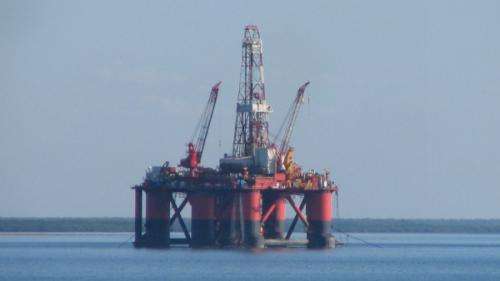Water jets help mobile oil rigs move on

The use of water jets to more easily extract the anchoring legs of mobile oil rigs from deep inside the ocean floor, allowing them to move to new worksites, is the focus of a study through the University of Western Australia.
The self-elevating mobile rigs, called jack-ups, retract their legs as often as every two months and the study has been carried out to determine the effect water jets have on extracting them from deep embedment in soft clay.
Without water jets, extracting a jack-up's three or four embedded legs relies on the lifting force of its buoyant hull, which means extraction from undrained clay can take weeks, costing an average of USD100,000 per day.
"The major problem with retraction, the biggest resistance, comes from suction," Omid Kohan, researcher with the Centre for Offshore Foundation Systems and ARC Centre of Excellence for Geotechnical Science and Engineering at UWA, says.
Mr Kohan's research shows this suction resistance can be significantly reduced by jetting water through the bottom of the leg and into the void that forms as the leg is lifted, a process called bottom jetting.
"When you use bottom jetting, the extraction should happen the same day, based on our tests [in the lab]," Mr Kohan says.
"In reality, other things can happen, because of other parameters [such as waves] that influence extraction."
In 2011, Mr Kohan's supervisors developed a numerical framework for estimating the effect of jetting flowrate on the force required to extract jack-up legs.
Mr Kohan's current research verifies and extends this framework to include leg footings embedded up to 60 metres, or three times the footing diameter, a current industry maximum and around twice the depth previously studied.
Spudcans scaled in a centrifuge
To study the effect of water jets on the extraction process, Mr Kohan created a 1:200 scale model of a jack-up's clay-embedded leg—complete with cone-shaped 'spudcan' footing at one end—then placed the model into UWA's geotechnical centrifuge, subjecting it to accelerations of 200 times gravity.
"When you use a centrifuge, everything scales up," he says. "The average loads in those simulations were close to what would happen in the field."
In the field, spudcans reach diameters of up to 23 metres, but Mr Kohan's model was limited by the physical size of the centrifuge strongboxes.
Mr Kohan used the same model to study top jetting—where water is squirted from the top of the spudcan, aiming to loosen and soften soil above—but found it was not as efficient as bottom jetting in helping the extraction process.
More information: Omid Kohan, Britta Bienen, Christophe Gaudin, Mark J. Cassidy, "The effect of water jetting on spudcan extraction from deep embedment in soft clay," Ocean Engineering, Volume 97, 15 March 2015, Pages 90-99, ISSN 0029-8018, dx.doi.org/10.1016/j.oceaneng.2015.01.002.
Provided by Science Network WA


















